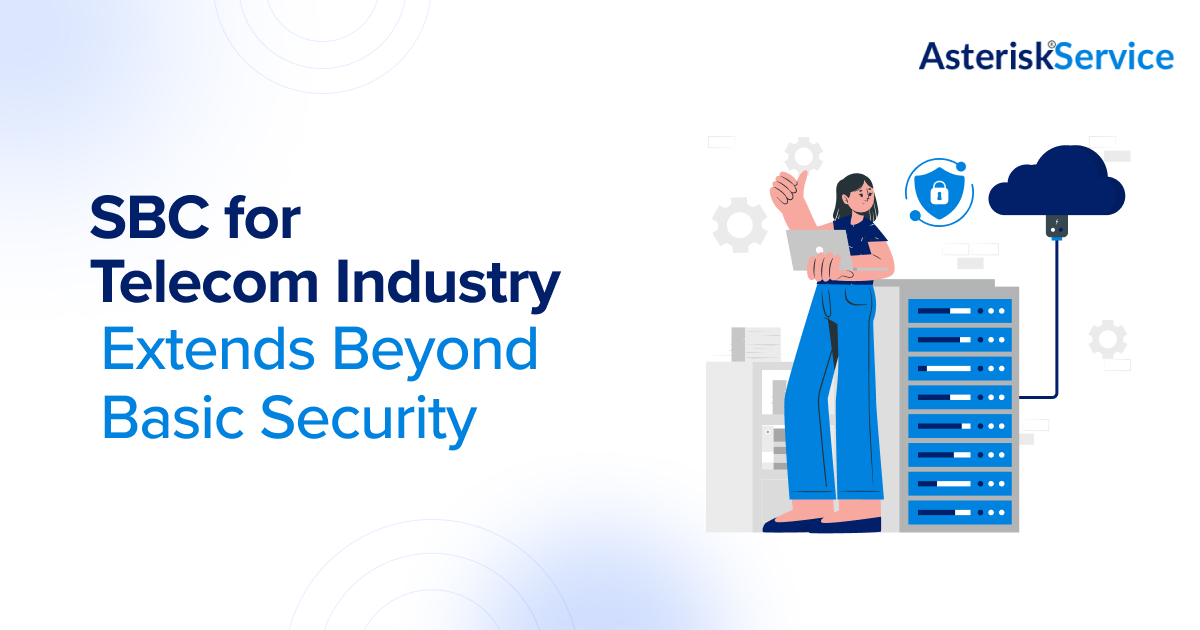
Technology has significantly changed the way we communicate compared to before. Integrating AI, 5G, and IoT in telecommunication technology has enhanced the scalability and accessibility of secure and efficient infrastructures. What remains the same is our constant efforts to secure our communication solutions. SBC in telecom is a critical component designed to ensure the security of communication solutions. SBCs also support intelligent call routing, real-time analytics, and call monitoring.
What are SBCs?
Session Border Controllers (SBC) are hardware devices or software applications deployed on the edges of any communication network to ensure security, smooth connectivity, traffic, and SIP session management.
What is SBC in Telecom?
Telecommunication, or telecom, is exchanging information or data through digital communication, be it voice, video, or instant messaging. SBCs secure this communication by ensuring efficiency and connectivity to end users.
SBC for Telecom Industry
1. Security and Protection
Encryption and Decryption – Provides robust encryption and decryption of data transmission over the internet.
Denial of Service attacks – Mitigates and cancels third-party interference and ensures smooth, uninterrupted communication.
Topology Hiding – Hides original IP addresses or IP locations to block unauthorized credentials to access data quickly.
2. QoS Management
Traffic Elimination – SBC eliminates unnecessary traffic that causes hindrances and prioritizes critical sessions, ensuring high-quality calls.
Bandwidth Management – Allocates and manages bandwidth effectively to ensure quality of service.
Jitter Buffering – SBC repairs the variations in packet transmission and improves latency or jitter buffering to ensure smooth, high-quality audio and video playback and help in telecom network optimization.
3. Media Services
Transcoding – Transcoders or Codecs compress and decompress data packets to reduce bandwidth while routing and connecting two networks operating in different languages.
Media Anchoring – Organizes media streams to improve quality and flexibility.
4. Call Routing and Load-Balancing
Call Routing – Prioritizes calls on a queue based on real-time presence, user preferences, and specific policies.
Load Balancing – SBCs help reduce overload on a single primary server by routing away the traffic based on health and availability.
5. Regulatory Compliance and Monitoring
Compliance Monitoring – Ensure adherence to HIPAA and GDPR and more regulatory compliance.
Lawful Interception – Support legal standards and requirements for blocking and recording communications.
6. Analytics and Reporting
Real-Time Monitoring – Provides real-time live status and track updates and performance metrics.
Analytics – Offers insights into trends, planning, and optimization.
7. New Technological Advancement
5G Integration – Integrating 5G ensures high-quality streams, reduces the possibility of latency and jitter, and improves playback performance.
AI and ML – AI-integrated SBCs are more advanced in attack pattern recognition, creating analytics, and recognizing trends.
Some Traditional Benefits of SBCs
An SBC has several tweaks and perks that empower your company to adopt a quicker and more cooperative communication approach.
- Quality of Service – SBCs allow your telecommunication organization to provide Quality Service to your customers by safeguarding your network routing from various cyber threats and attacks and reducing unnecessary traffic engagement.
- Reliability – SBC ensures your organization’s telecommunications solution is regulatory compliant by enforcing standard rules and regulations, saving you from violation charges and reputational damage.
- Security—SBC ensures the security of your organization’s network by hiding the sender and receiver’s original IP addresses and managing your network for failovers and load balancing
Challenges and Considerations
Integrating SBCs in communication presents challenges and considerations, whether deployment complexity or adjusting costs in existing infrastructures. Additionally, with technological evolution, SBCs must evolve with emerging trends and threats and require regular updates. Ensuring regulatory compliance with standards such as HIPAA and GDPR is also critical.
A Recap
SBC integrated communication solutions can do wonders for your telecommunication entity. They are critical for ensuring security and IP flow in VoIP and multimedia communications, enhancing scalability, and ensuring regulatory compliance.
FAQs
What is the purpose of a Session Border Controller?
The purpose of the Session Border Controller is to protect and regulate the IP flow or sessions in any communicating network.
Is a Session Border Controller necessary?
A session Border Controller is necessary to ensure security and connectivity between private and public networks, filter traffic, and enhance efficiency.
What are the characteristics of SBCs?
SBCs provide several characteristics for your enterprise network, such as transcoding, topology hiding, load balancing, Fail-overs, and Security.
Is a Session Border Controller a Firewall?
A Session Border Controller acts as a firewall for SIP-based attacks and prevents malicious attacks and threats to the network.